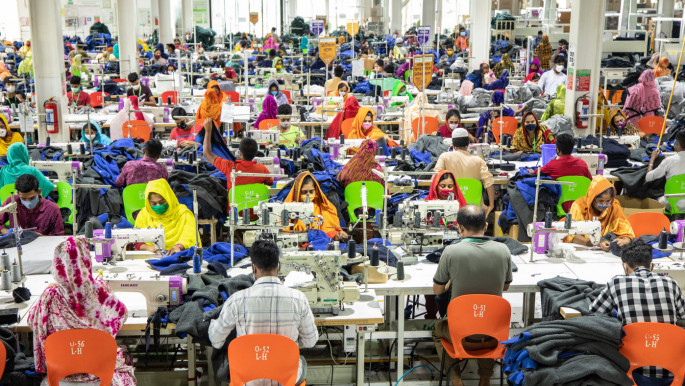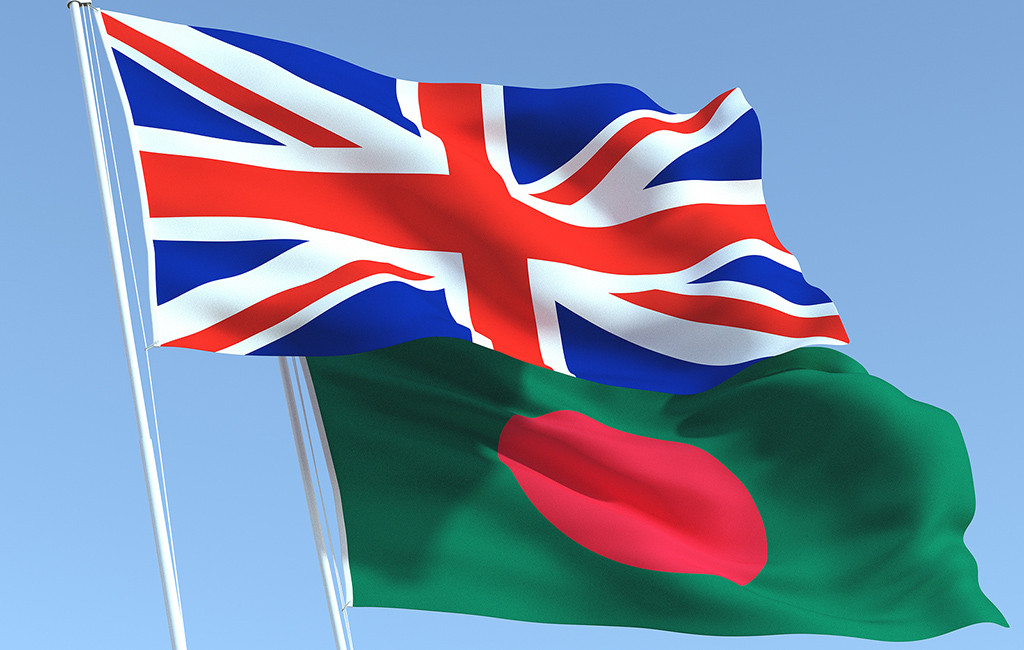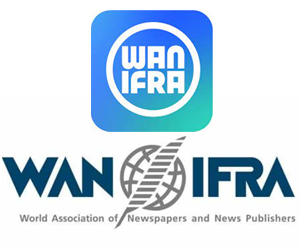Bangladesh
Bangladesh at 50: From ‘basket case’ to rising economic star
Published
3 years agoon

As Bangladesh marks the 50th anniversary of its victory, experts note that it has transformed itself from an economic “basket case” into one of the world’s fastest-growing economies.
When Pakistani forces laid down arms in Bangladesh’s bloody liberation war, the newly-independent South Asian nation’s economy was in tatters. Over 80 per cent of the population were living in extreme poverty.
In the following years, the country struggled with military coups, political turmoil, poverty and famine. Now, as Bangladesh country celebrates its 50th Victory Day, the situation appears to have dramatically changed for the better.
The holiday commemorates the victory of the Bangladesh forces over Pakistani forces in the Bangladesh Liberation War on December 16, 1971.
In the 1970s, it was argued that “if development is possible in Bangladesh, it is possible in any other country,” Mustafizur Rahman, an economist at Bangladesh’s Center for Policy Dialogue, told DW.
He added that the South Asian country was viewed as “the test case” of development.
Norwegian social researcher Eirik G. Jansen said, however, that when he returned to a Bangladeshi village in 2009 after a gap of nearly three and a half decades, he was surprised to see the remarkable improvement in socioeconomic development and people’s income levels.
“Their incomes increased tenfold. It meant they could buy at least 10-15 kilograms of rice with their daily wages,” Jansen told DW.
“If you have five or six people in your household and you come home with just one and a half kilograms of rice, you can hardly feed the entire family,” Jansen said.
“Severe poverty meant many people lacked enough food. Health and education services hardly existed. Many people became sick, and many died in their 40s and 50s due to diseases that could have been prevented if they had good nutrition. Many children also died,” the expert added.
Making strides in growth and development
Before the onset of the coronavirus pandemic, the economy was growing rapidly, recording an annual expansion in the range of 8 per cent for years.
The Asian Development Bank said that despite the hit from the pandemic, the Bangladeshi economy is recovering fast.
“Bangladesh also grows enough food now to feed its 167 million people. The country has a significantly reduced maternal and infant mortality rate than many other countries in the world,” Rahman said.
Bangladesh achieved lower middle-income country status in 2015 and is on track to leave the United Nations’ Least Developed Countries list.
Currently, 98 per cent of children nationwide have finished primary school, with more girls in secondary school than boys.
Observers say the Muslim-majority nation over the years has invested heavily in the lives of women and girls. It has also made progress in combating child malnutrition and reproductive health.
Jansen said when he visited the village in Manikanj again in 2010, he found that schools in the area were refurbished, and both boys and girls were going to school.
The improvement in female education has transformed the socioeconomic structure, he pointed out.
“Providing scholarships for women’s and girls’ education is another factor. The women are now more articulate. They are not as shy as when I saw them four decades earlier.”
From agriculture to industry
With a GDP of over $409 billion (€362 billion), Bangladesh currently has the world’s 37th largest economy and forecasts suggest that the size of the economy could double by 2030.
While it was primarily an agricultural economy in 1971, the composition has changed over the decades, with industry and services now accounting for the lion’s share of economic output. Agriculture’s share of GDP has dropped to just 13 per cent.
It was the availability of job opportunities outside agriculture that drove economic development, said Jansen.
“For many women, it was working in the textile industry and handicrafts. For men, it was jobs in local small industries. For some, it was migrating abroad to the Middle East, Singapore or Malaysia.”
The garment industry emerged as one of the nation’s success stories in recent decades. It is the second-largest globally, only surpassed by China, and rakes in over $35 billion a year from exports.
The sector employs 4 million people, the majority of whom are women, contributing to female empowerment.
“The garment sector has changed not only the economy, but also women’s social status in Bangladesh,” Rahman said. Meanwhile, the Bangladesh government has set an overall target for exports amounting to $51 billion in 2022.
Remittances also play a major role in the economy, with Bangladeshi workers employed abroad transferring nearly $24.7 billion in the fiscal year 2021.
Quality and inequality challenges
Despite the steep rise in the number of children going to school, the quality of education remains poor, posing a major challenge to the development of a skilled workforce, said Rahman.
Also, not everyone has benefited equally from the nation’s impressive growth and development, say experts, pointing to rising income and wealth inequality, as well as the slow pace of job creation.
“Per capita income has increased in Bangladesh. But income and wealth distribution could be made equal and fair,” Rahman said. “The income disparity between the top 5 per cent and the bottom 40 per cent is increasing day by day.”
Another problem is the heavy concentration of economic activity in big cities like Dhaka and Chittagong, resulting in a huge rural-urban divide and increased urban poverty.
“The poverty level might have come down to 20 per cent, but 50 per cent of those living in some cities face poverty,” Rahman stressed.
As it marks Victory Day, the biggest challenge Bangladesh faces is related to how the country ensures that the fruits of growth and development reach people at the bottom of the economic pyramid
You may like
-


World Bank Helps 900,000 Rural Youth in Bangladesh with Better Employability and Entrepreneurial Opportunities
-


Bangladesh Receives $858 Million World Bank Financing to Improve Climate Resilient Agriculture Growth and Road Safety
-


Sri Lanka pays back $50 million to Bangladesh
-


UK: Bangladesh makes huge progress in last 20 years
-


ASUS launched four incredible laptops in Bangladesh
-


World Bank Managing Director to Visit Bangladesh
Bangladesh
Bailey Road Fire | a wake-up call for commercial buildings and beyond
Published
5 months agoon
March 8, 2024
M. Mahmudur Rashid
Vice President,Electronics Safety and Security Association of Bangladesh – ESSAB
We always talk about the unsafe conditions of old Dhaka, but the tragic incident of Bailey Road is an example of how we are building a new Dhaka. It is not an accident; it is the result of our actions. From the building owner to the authorities, everyone is equally responsible. Unplanned restaurants have been built on every floor of many multi-storied buildings. If not aware now, dire consequences are waiting for us. We have to think again, which is more expensive? The price of safety equipment or the price of life!
Building on Bailey Road – Green Cozy Cottage has permission from Rajuk as a mixed-use (commercial office and residential apartments), building type: E and R. It is absolutely illegal to set up a commercial kitchen/restaurant in a building without proper permission and occupancy approval. Green Cozy Cottage should have fire safety plans approved by the Fire Service and Civil Defence.
The building should have fire exits with fire doors, evacuation paths, fire alarm systems and fire-fighting systems. Apart from that, a commercial kitchen/restaurant kitchen hood should have a specially designed automatic wet chemical type fire suppression system. Fire protection systems for a typical office or shopping area and a restaurant are not the same. Each restaurant had a live fire inside the building. They should also have a fire-separated area for storing cooking oil and gas.
But, unfortunately, Green Cozy Cottage has no fire exit with a fire door, no fire hydrant system and no kitchen fire suppression system in any of the restaurants. There were large LPG gas cylinders on each landing of the stairs. Here are some recommendations to prevent these types of fire hazards –
Responsibility of building owner/user-
• Building construction according to BNBC.
• Do not change occupancy without proper authorization and arrangements.
• Maintain proper fire exits with fire doors, emergency lighting systems, fire alarm systems and fire hydrant systems.
• Install automatic fire sprinkler systems where required.
• Install wet chemical-type kitchen suppression systems for kitchen hoods.
• Store cooking oil, LPG gas and other flammable items in fire-separate zones. It also requires permission to do so.
• A refuge area is recommended in multi-storied buildings to take shelter in case of a fire accident.
• Use high-quality electrical appliances, accessories, electrical wiring and ovens.
• Use proper ventilation and fire-rated dampers in central HVAC ducts.
• Use CO2 or ABC powder extinguishers with a minimum capacity of 6 kg per 550 square feet area.
• Use wet chemical extinguishers for class K fires (cooking oil/fat).
• Regularly maintain and check all electrical and safety equipment.
• Every establishment needs a trained rescue and fire-fighting team.
• Arrange regular fire drills, at least once every six months.
Government responsibility
• Ensure enforcement of building codes and make necessary renovations
• Facilitate the import of fire safety equipment, all establishments including commercial buildings need duty free facilities to import fire safety equipment like export-oriented factories.
• Need to reduce the 7.5% VAT on the supply of fire safety equipment and 15% VAT on the consultancy service of fire safety plan.
• Prevent import and marketing of defective and substandard fire safety equipment
• Encourage banks to invest in procurement of fire safety equipment on easy terms
• Popularize fire insurance.
• Take action against those who construct dangerous buildings and structures in violation of the law
• Incorporate fire safety and disaster management into the education system
• Incentive package needed for entrepreneurs to start manufacturing and investing in fire safety equipment business in Bangladesh.
• Build adequate fire hydrants on roads and reservoirs in cities
• Enhancing fire service capacity through new technology and manpower
Public Responsibilities:
• Avoid renting and using unsafe buildings
• Get basic training in the use of fire safety equipment
• Construct buildings/structures by building codes and fire safety regulations
• Install proper fire safety equipment in every house, office, shop, and factory.
• Be careful when using all types of electrical and gas appliances
• Follow all safety instructions and signage.
Bangladesh
Bangladesh’s apparel export to USA dips over 25% in 2023
Published
6 months agoon
February 10, 2024
Bangladesh’s apparel shipments to the United States, its single largest export destination in 2023, declined 25% year on year to $7.29 billion due to high inflation caused by the ongoing Russia-Ukraine war.
Bangladesh’s apparel exports to the US was $9.72 billion in 2022, according to the US Department of Commerce’s Office of Textiles and Apparel (Otexa) data.
The data also mentioned that the country’s overall apparel imports also declined 22.04 % year on year to $77.84 billion, while the import value was $99.86 billion a year ago.
In terms of volume, Bangladesh RMG export to the USA in 2023 also plunged about 28% to 2.25 billion square metres from 3.13 billion square metres in 2022, according to the Otexa data.
Talking to The Business Standard, Bangladesh Garment Manufacturers and Exporters Association President Faruque Hassan said that the global apparel market was very volatile in 2023 as every country has reduced their imports due to high inflation driven by the Russia-Ukraine war.
He said that the largest apparel importer country – the US – also decreased their consumption due to the high inflation in 2023.
He said Bangladesh was not the only country which experienced negative growth in apparel export to the US market; every exporting country had the same experience in 2023.
The BGMEA president hoped that this market will be better in the coming days.
He also mentioned that the US inflation and interest would be stable, which may help the market rebound in coming months.
The share of Bangladeshi apparel in the US market was about 10% in in 2022, while it fell to 9.37% last year.
However, Bangladesh’s position remained unchanged as the third-largest apparel exporter to the US market after China and Vietnam, which occupied their positions with 20.96% and 18.21% share respectively.
The OTEXA data showed, in 2023, Chinese apparel export to the USA fell 10.83% to $16.32 billion from $21.75 billion a year ago.
Vietnam and India’s apparel exports in 2023 decreased 22.29% and 21.42% respectively.
Indonesia and Cambodia’s apparel export to the United States fell 25.19% and 23.58% respectively in the year.
Bangladesh
UK: Bangladesh makes huge progress in last 20 years
Published
1 year agoon
January 29, 2023
British High Commission Dhaka’s Development Director Matt Cannell has said the government of Bangladesh has made huge development over the last twenty years.
Cannell said: “The UK has a strong and vibrant partnership with the government of Bangladesh in a range of areas, including diplomacy, trade and development.”
He said they are increasing their work to help end preventable deaths of mothers and newborn children in 11 countries around the world, including in Bangladesh.
“I would like to particularly applaud the work of newly trained midwives in improving maternal and newborn health care,” Cannell added.
Head of Human Development Department of the Foreign, Commonwealth and Development Office in the UK Chris Carter said Bangladesh is rightly applauded for its family planning and immunization programs, and the government’s commitment to driving down maternal and child deaths, such as the Bangladesh Every Newborn Action Plan.
“We hope to do more to help build on these efforts. It has been incredible to see the beginning of another Bangladesh success story to develop a new icddr.b alternative formula for Ready-to-use Therapeutic Food (RUTF),” Carter said.
The British High Commission Dhaka recently co-hosted a roundtable with the government of Bangladesh and other development partners to discuss how to step up efforts to end preventable deaths of mothers, babies and children in Bangladesh.
Director General of Directorate General of Health Services (DGHS) Prof Dr Abul Bashar Mohammed Khurshid Alam attended the roundtable as the chief guest.
Chris Carter set out how the UK plans to work closely with the government and partners to sustain and build on Bangladesh’s progress on ending preventable deaths.
This includes working on quality, affordable health services and also addressing underlying issues, such as poor nutrition.
The roundtable included an initial consultation about how to tackle the remaining issues that cause preventable deaths of mothers, babies and children in Bangladesh.
This will help to inform the UK’s approach and identify areas where the UK, the government of Bangladesh and other partners can intensify their collaboration, said the British High Commission in Dhaka on Sunday.

Progressive Life Insurance Company organizes 199th Board Meeting

Divine IT Conducts Training on Bangladesh Energy Regulatory Commission’s Uniform System of Accounts for Standardized Gas Sector Accounting in Bangladesh

Bangladeshi Startup Celebrates Success at VivaTech 2024, Unveils Future Plans










